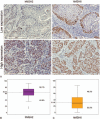Overexpression of MutSα Complex Proteins Predicts Poor Prognosis in Oral Squamous Cell Carcinoma
- PMID: 27258499
- PMCID: PMC4900707
- DOI: 10.1097/MD.0000000000003725
Overexpression of MutSα Complex Proteins Predicts Poor Prognosis in Oral Squamous Cell Carcinoma
Abstract
The DNA mismatch repair (MMR) system is responsible for the detection and correction of errors created during DNA replication, thereby avoiding the incorporation of mutations in dividing cells. The prognostic value of alterations in MMR system has not previously been analyzed in oral squamous cell carcinoma (OSCC).The study comprised 115 cases of OSCC diagnosed between 1996 and 2010. The specimens collected were constructed into tissue microarray blocks. Immunohistochemical staining for MutSα complex proteins hMSH2 and hMSH6 was performed. The slides were subsequently scanned into high-resolution images, and nuclear staining of hMSH2 and hMSH6 was analyzed using the Nuclear V9 algorithm. Univariable and multivariable Cox proportional hazard regression models were performed to evaluate the prognostic value of hMSH2 and hMSH6 in OSCC.All cases in the present cohort were positive for hMSH2 and hMSH6 and a direct correlation was found between the expression of the proteins (P < 0.05). The mean number of positive cells for hMSH2 and hMSH6 was 64.44 ± 15.21 and 31.46 ± 22.38, respectively. These values were used as cutoff points to determine high protein expression. Cases with high expression of both proteins simultaneously were classified as having high MutSα complex expression. In the multivariable analysis, high expression of the MutSα complex was an independent prognostic factor for poor overall survival (hazard ratio: 2.75, P = 0.02).This study provides a first insight of the prognostic value of alterations in MMR system in OSCC. We found that MutSα complex may constitute a molecular marker for the poor prognosis of OSCC.
Conflict of interest statement
All authors state they have no potential conflicts of interest to declare.
Figures




References
-
- Li GM. Mechanisms and functions of DNA mismatch repair. Cell Res 2008; 18:85–98. - PubMed
-
- Stark AM, Doukas A, Hugo HH, et al. Expression of DNA mismatch repair proteins MLH1, MSH2, and MSH6 in recurrent glioblastoma. Neurol Res 2015; 37:95–105. - PubMed
-
- Modrich P, Lahue R. Mismatch repair in replication fidelity, genetic recombination, and cancer biology. Annu Rev Biochem 1996; 65:101–133. - PubMed
Publication types
MeSH terms
Substances
LinkOut - more resources
Full Text Sources
Other Literature Sources
Medical

